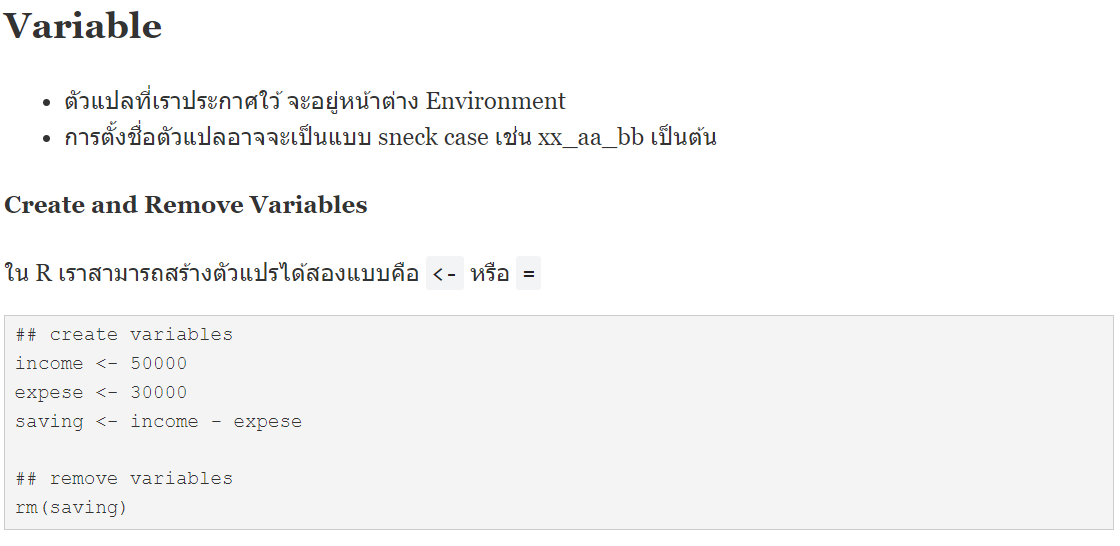R Data structure Vector, Matrix, List, DataFrame
4 ต.ค. 2023 , 901 Views , หมวดหมู่ R Programming โค๊ดดิ้ง , ป้ายกำกับ:DataFrame, List, Matrix, R Data structure, Vector
Vector — เก็บข้อมูลได้ 1 data type
หนึ่ง Vector เก็บข้อมูลได้แค่ 1 ประเภท
R
|
1 2 3 4 5 6 7 8 9 10 11 12 13 14 15 16 17 18 19 20 21 22 |
1:10 # 1 2 3 4 5 6 7 8 9 10 16:25 #16 17 18 19 20 21 22 23 24 25 ## sequence generation seq(from = 1, to = 100, by = 5) # 1 6 11 16 21 26 31 36 41 46 51 56 61 66 71 76 81 86 91 96 ## help file help("seq") ## function c friends <- c("Daviid", "Marry", "Anna", "John", "William") ages <- c(20, 35, 43, 18, 27) is_mail <- c(TRUE, FALSE, FALSE, TRUE, TRUE) print(friends); print(ages); print(is_mail) # "Daviid" "Marry" "Anna" "John" "William" # 20 35 43 18 27 # TRUE FALSE FALSE TRUE TRUE |
…
PHP
|
1 2 3 4 5 6 7 8 9 10 11 12 13 14 15 16 17 18 19 20 21 22 23 |
## vector friends <- c("Nathan","Koy","Gle","King") length(friends) #เชคความยาว #เข้าไปดึงค่าใน obj นั้นขึ้นมา friends[1] # "Nathan" friends[3:5] # "Gle" "King" NA friends[c(1,3,4)] # "Nathan" "Gle" "King" #เปลี่ยนค่าใหม่ friends[1] <- "Ditto" friends # "Ditto" "Koy" "Gle" "King" friends[1:2] <- c("A","B") friends # "A" "B" "Gle" "King" ## หาตำแหน่ง index which(friends == "Gle") # 3 |
Matrix
เก็บข้อมูลได้ 1 ประเภท แต่จะมี 2 dimension คือ column และ row สร้าง Matrix ด้วยคำสั่ง matrix()
R
|
1 2 3 4 5 6 7 8 9 10 11 12 13 14 15 16 17 18 19 20 21 22 23 24 25 26 27 28 29 30 31 32 33 34 35 36 37 38 39 40 |
m <- matrix(1:10, ncol = 2) m # [,1] [,2] # [1,] 1 6 # [2,] 2 7 # [3,] 3 8 # [4,] 4 9 # [5,] 5 10 m <- matrix(1:10, ncol = 2, byrow = TRUE) m # [,1] [,2] # [1,] 1 2 # [2,] 3 4 # [3,] 5 6 # [4,] 7 8 # [5,] 9 10 ## element wise computation m*2 # [,1] [,2] [,3] [,4] [,5] # [1,] 2 4 6 8 10 # [2,] 12 14 16 18 20 # [3,] 22 24 26 28 30 # [4,] 32 34 36 38 40 m <- matrix(c(1,2,3), ncol = 2) y <- matrix(c(4,5,6), ncol = 2) m*y # [,1] [,2] # [1,] 4 18 # [2,] 10 4 y <- 1:6 dim(y) <- c(3,2) y # [,1] [,2] # [1,] 1 4 # [2,] 2 5 # [3,] 3 6 |
List — เก็บได้หลาย data type
- เก็บข้อมูลแบบ key = value
- เก็บข้อมูลได้หลากหลายประเภท สร้าง List ด้วยคำสั่ง list()
R
|
1 2 3 4 5 6 7 8 9 10 11 12 13 14 15 16 17 18 19 20 21 22 23 24 25 26 27 28 29 30 31 32 33 34 35 36 37 38 39 40 41 42 43 44 45 46 47 48 49 50 51 |
my_playlist <- list( fav_movie = "The Dark Knight", fav_song = "OMG", fav_artist = "NewJeans" ) my_playlist$fav_movie # "The Dark Knight" my_playlist[1] # $fav_movie # "The Dark Knight" my_playlist[[1]] # "The Dark Knight" my_playlist <- list( fav_movie = c("The Dark Knight","Marvel"), fav_song = c("OMG","XX"), fav_artist = "NewJeans" ) my_playlist$fav_movie[2] my_playlist[[1]][2] # "Marvel" ## customer database for our company customer_01 <- list( name = "Nathan", location = "BKK", age = 38, movies = c("John Wick", "Dark Knight") ) customre_02 <- list( name = "moh", lname = "wick", age = 42, movies = "john Wick 4", fav_weapon = "A Pencil" ) customer_db <- list( nathan = customer_01, moh = customre_02 ) customer_db$nathan$name # "Nathan" ## อยากรู้ key names(customer_db) # "nathan" "moh" |
Data Frame
คือ Table นั่นเอง ความรู้เรื่อง Data Frame เป็นพื้นฐานสำคัญของ Data Analists งานของเรามากกว่า 80% ทำงานกับ structured data เช่น ข้อมูลใน Excel/ Google Sheets และที่เราดึงออกมาจาก SQL databases
- สร้าง Data Frame ด้วย
data.frame() - Create data frame จาก vector ซึ่ง vector ต้องมีความยาวเท่ากัน
R
|
1 2 3 4 5 6 7 8 9 10 11 12 13 14 15 16 17 18 19 20 21 22 23 24 25 26 27 28 29 30 31 32 33 34 35 36 37 38 39 40 41 42 43 44 45 46 47 48 49 50 51 52 53 54 55 56 57 58 59 60 61 62 63 64 65 66 67 68 69 |
#แสดงชื่อ build-in data frame data() mtcars #build-in data frame ## create data frame from vector friends <- c("Nathan","Koy","gle","Kung","Noi") ages <- c(37,32,7,0,6) movie_lover <- c(T,F,T,F,T) df <- data.frame(id = 1:5, friend=friends, age=ages, movie =movie_lover) df # id friend age movie # 1 1 Nathan 37 TRUE # 2 2 Koy 32 FALSE # 3 3 gle 7 TRUE # 4 4 Kung 0 FALSE # 5 5 Noi 6 TRUE # alterative approach to create data frame in R customrers <- list( friends = c("John",NA), ages = c(23,45), movie = c(T,F) ) df <- data.frame(customrers) View(df) ## ตรวจสอบค่าว่าง is.na(df) ## หาจำนวนค่า NA sum(is.na(df)) ## วิธีดึงข้อมูล df$friends[2] df[[1]][2] ## ดึงทุก row , coloumn 2:3 df[ ,2:3] ##ดึง row 1:3, ทุก column df[1:3, ] ## df[, c(1,3)] df[ ,c("ages","friends")] ## lisa_index <- which(df$friends == "John") lisa_index df[lisa_index, "friends"] <- "Nathannnnnnn" ## ดึงข้อมูลตามเงื่อนไข df[df$age < 30, ] df[!df$movie, ] #ดึง row ที่ไม่ชอบดูหนัง #ดึงหลายเงื่อนไข and (&) or (|) condition <- !df$movie & df$ages > 30 #and df[condition, ] condition <- !df$movie | df$ages > 30 #or df[condition, ] #export เป็น csv write.csv(df, "friends.csv", row.names = FALSE) #read csv df <- read.csv("friends.csv") |
Subset
ดึงข้อมูลออกมาจาก Data structure Subset ด้วย Position, name, condition
ดึงจาก Vector
R
|
1 2 3 4 5 6 7 8 9 10 11 12 13 14 15 16 17 18 19 20 21 22 23 24 25 26 27 28 29 30 31 |
friends <- c("Daviid", "Marry", "Anna", "John", "William") ages <- c(20, 35, 43, 18, 27) ## by position friends[1] # "Daviid" friends[2] # "Marry" friends[1:4] # "Daviid" "Marry" "Anna" "John" friends[c(1,2,5)] # "Daviid" "Marry" "William" ## by condition ages[ages > 30] # 35 43 ages[ages <= 30] # 20 18 27 ## by name ใช้ function names() names(ages) <- friends ages # Daviid Marry Anna John William # 20 35 43 18 27 ages["Marry"] # Marry # 35 ages[c("Marry", "Anna", "John")] # Marry Anna John # 35 43 18 |
ดึงจาก Data frame
R
|
1 2 3 4 5 6 7 8 9 10 11 12 13 14 15 16 17 18 19 20 21 22 23 24 25 26 27 28 29 30 31 32 33 34 35 36 37 38 39 40 |
## df[row, col] ## by position df[1, 3] # "Bangkok" df[1:2, 4] # TRUE TRUE df[1:2, 2:4] # ages location movie # 1 20 Bangkok TRUE # 2 35 Mahasarakham TRUE ## by name df[ ,"friends"] # "Daviid" "Marry" "Anna" "John" "William" df[, c("friends", "location")] # friends location # 1 Daviid Bangkok # 2 Marry Mahasarakham # 3 Anna Surin # 4 John Konkean # 5 William Loei ## by condition ให้ใส่เงื่อนไขใน row df[ df$friends=="Marry", ] # friends ages location movie # 2 Marry 35 Mahasarakham TRUE df [ df$movie==TRUE, c("friends", "ages", "movie")] # friends ages movie # 1 Daviid 20 TRUE # 2 Marry 35 TRUE # 5 William 27 TRUE df[ df$ages < 30, ] # friends ages location movie # 1 Daviid 20 Bangkok TRUE # 4 John 18 Konkean FALSE # 5 William 27 Loei TRUE |
ป้ายกำกับ:DataFrame, List, Matrix, R Data structure, Vector
หมวดหมู่
- Android (2)
- AWS (24)
- Git (4)
- IT (50)
- jQuery,JavaScript,Ajax (46)
- Laravel (26)
- Linux (36)
- MySQL (42)
- PHP (51)
- Power BI (9)
- Python (1)
- R Programming (3)
- Recent Projects (10)
- VtigerCRM Dev (2)
- WebDesign (38)
- WordPress (12)
- ทุกหมวดหมู่ (171)
- นอกจากนั้น (17)
- วาดภาพด้วยแสง (15)
- หุ้น (2)
- โค๊ดดิ้ง (237)
Popular Posts
- ปริ้น PDF หน้า/หลัง จากโปรแกม Adobe Acrobat Reader และ Browser Chrome 181.5k views
- เปลี่ยนภาษาต่างดาวเป็นภาษาไทยใน Excel ด้วย Excel 162.5k views
- ขนาดรูปมาตรฐานและการเตรียมไฟล์ให้ตรงกับขนาดที่จะอัดรูปหรือล้างรูป 156.5k views
- วิธีพิมพ์รูปติดบัตร 1 นิ้ว 2 นิ้ว จาก PhotoScape 149k views
- ฟรี Photoshop Online Photopea แก้ไขแต่งรูป Online เหมือน Photoshop เป๊ะ 120.9k views
- ตัวอย่างข้อความ Autoresponder Email Messages ภาษาอังกฤษ เวลาที่ไม่ได้อยู่ Office หรือลาพักร้อน 114.8k views
- รวมวิธีแก้ปัญหา ภาษาไทยอ่านไม่ออก ใน PHP,MySQL 81.8k views
- ปริ้นหน้า/หลัง จาก Word 52.8k views
- Save รูปภาพจาก Instagram ลงคอมพิวเตอร์ โดยไม่ต้องใช้ปลั๊กอิน 49.8k views
- วิธีนำ Google Font มาใช้ในเว็บไซต์ 26.2k views
ป้ายกำกับ
adobe
Android
Apache
array
aws
Bootstrap
command
css
csv
dark theme
ec2
excel
Facebook
font
fullCalendar
git
google
Google Chrome
Google Docs
google map
highcharts
HTML
icon font
javascript
jQuery
laravel
Linux
mysql
mysqli
Navicat
password
Photoshop
php
phpexcel
phpmyadmin
power bi
text
txt
Ubuntu
Windows
windows10
wordpress
wordpress theme
xampp
ภูสอยดาว

